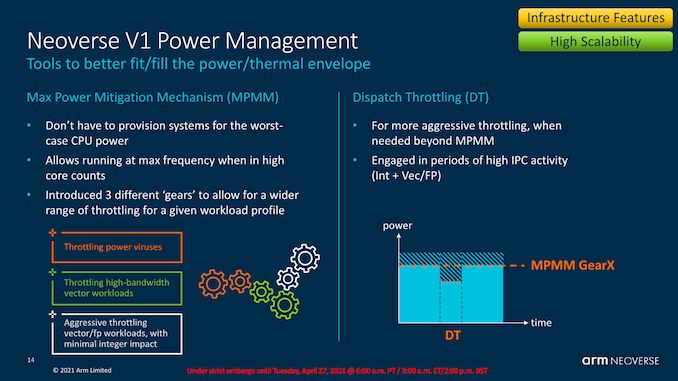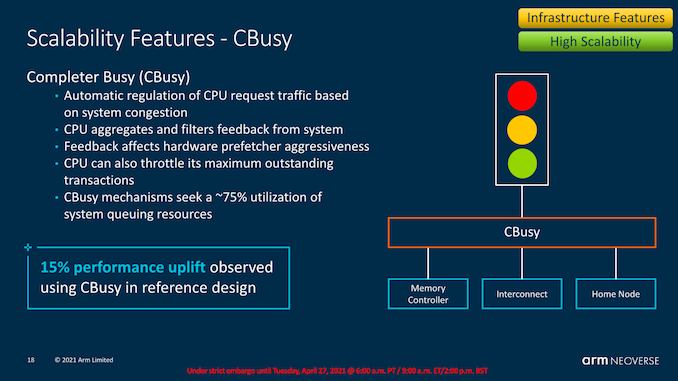Arm Announces Neoverse V1, N2 Platforms & CPUs, CMN-700 Mesh: More Performance, More Cores, More Flexibility
by Andrei Frumusanu on April 27, 2021 9:00 AM EST- Posted in
- CPUs
- Arm
- Servers
- Infrastructure
- Neoverse N1
- Neoverse V1
- Neoverse N2
- CMN-700
The Neoverse V1 Microarchitecture: Platform Enhancements
Aside from the core-side microarchitectural aspects of the V1, the new design also features some new system-facing novelties that promise to help vendors integrate the CPU IP better in larger scale implementations.
MPAM, or Max Power Mitigation Mechanism is a new fine-grained (to around 100 clock cycles) power management mechanism that promises to help smooth out the power behaviour of the core, and allow vendors’ implementations of the chip’s power delivery mechanisms to be so to say, be built to lesser requirements.
As we’ve seen in our review of the Ampere Altra, instead of fluctuating frequency at maximum TDP like how most x86 CPUs behave right now, the chip rather prefers to stay most of the time at maximum frequency, with the actual power consumption many times landing in at quite below the TDP (maximum allowed power consumption). A mechanism such as MPAM would allow, if possible, for the system’s average frequency to be higher by throttling the power limited cores to a finer degree. The mechanism to which this can be achieved can also include microarchitectural features such as dispatch throttling where the core slows down the dispatched instructions, smoothing out high power requirements in workloads having high execution periods, particularly important now with the new wider 2x256b SVE pipelines for example.
MPAM is a different mechanism helping interactions in larger system implementations. The Memory partitioning and monitoring feature is supposed to help with quality of service and reducing side-effects of noisy neighbours in deployments where multiple workloads, such as multiple VMs or processes, operate on the same system. This naturally requires software-hardware cooperation and implementation, but should be something that is particularly helpful in cloud environments.
CBusy or Completer Busy is also a new system-side mechanism where the CPU cores interact with the mesh interconnect on a feedback-based basis, where the CPUs can vary their memory prefetcher aggressiveness depending on the overall mesh and system memory load. This ties in with the previously mentioned dynamic prefetcher behaviour where one can have the best of both worlds – better prefetching for more performance per core when the bandwidth is available, and very conservative prefetching when the system is under high load and there’s no room for wasted speculative bandwidth and data transfers.













95 Comments
View All Comments
Oxford Guy - Tuesday, April 27, 2021 - link
‘Fast-forward to 2021, the Neoverse N1 design today employed in designs such as the Ampere Altra is still competitive, or beating the newest generation AMD or Intel designs – a situation that which a few years ago seemed anything but farfetched.’Hmm... That last bit is odd. Either it’s just ‘farfetched’ or it’s ‘expected’.
eastcoast_pete - Tuesday, April 27, 2021 - link
Yes, those slides look very promising; now eagerly awaiting an eventual test of one or two of these in a actual silicone. I guess then we'll see how they measure up.mode_13h - Tuesday, April 27, 2021 - link
Silicone - From Wikipedia, the free encyclopediaNot to be confused with the chemical element silicon.
A silicone or polysiloxane is a polymer made up of siloxane (−R2Si−O−SiR2−, where R = organic group). They are typically colorless, oils or rubber-like substances. Silicones are used in sealants, adhesives, lubricants, medicine, cooking utensils, and thermal and electrical insulation.
eastcoast_pete - Thursday, April 29, 2021 - link
I'll have to take this up with auto-correct. It keeps changing silicon to silicone. Now that I forced it again to leave silicon alone (for the umpteenth time), maybe it will stop (:Mondozai - Tuesday, April 27, 2021 - link
Fantastic overview by Andrew. AT's most underrated reporter. Hopefully he gets more responsibility to cover more things in the future.Linustechtips12#6900xt - Tuesday, April 27, 2021 - link
AGREEDdotjaz - Tuesday, April 27, 2021 - link
Good, finally confirmed N2 is in fact ARMv9 as suspected. Now we'll just have to wait and see how the new mobile counterparts are. Hopefully we'll see some real improvements.It'll be interesting to see how small the new low power v9 core is given that it has to have a 128b SVE2 pipeline instead of 2x64b NEON.
mode_13h - Wednesday, April 28, 2021 - link
> finally confirmed N2 is in fact ARMv9 as suspected.> Now we'll just have to wait and see how the new mobile counterparts are.
> Hopefully we'll see some real improvements.
The data presented on N2 doesn't give me much hope that v9 changed much, besides the feature baseline. I was hoping for something slightly revolutionary, but it's certainly not that.
dotjaz - Thursday, April 29, 2021 - link
> hoping for something slightly revolutionaryWe've known for a couple of years ARMv9 is just ARMv8.x rebased. Your hopes weren't realistic to begin with. Besides, what "revolutionary" features would you expect ISAs to include? Can oyu name one? ARMv8.5a+SVE2 already has everything you need to design an excellent and efficient uarch. Why re-invent the wheel just for the sake of it?
mode_13h - Thursday, April 29, 2021 - link
> We've known for a couple of years ARMv9 is just ARMv8.x rebased.You knew this according to where? It's one thing to assume that, and clearly it wasn't an unreasonable assumption, but it's another thing to *know* it. So, how did you *know* it?
> Besides, what "revolutionary" features would you expect ISAs to include? Can oyu name one?
It's a fair question. Generally speaking, anything that would help improve efficiency. Maybe things like scheduling hints or maybe some kind of tags to indicate memory writes that are thread-private and terminal reads. Just some examples, off the top of my head.
> ARMv8.5a+SVE2 already has everything you need to design an excellent and efficient uarch.
The issue I see is that IPC and efficiency gains are going to become ever more hard-won, so there needs to be some more creativity in redefining the SW/HW interface to unlock further gains. ARMv9 is going to be with us for probably another decade and it could end up having to compete with yet-to-be-identified alternatives like maybe RISC VI or something completely out of left-field. So, I see it as a wasted opportunity. A pragmatic decision, for sure, but a little disappointing.